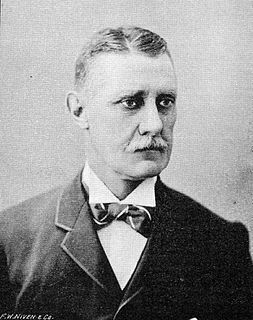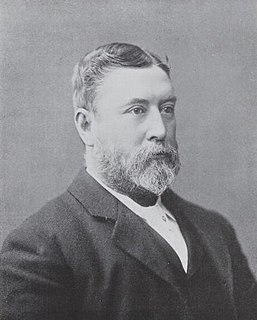The Australasian Sketcher with Pen and Pencil was a monthly magazine published in Melbourne by The Argus between 1873 and 1889.
Contents

The Australasian Sketcher with Pen and Pencil was a monthly magazine published in Melbourne by The Argus between 1873 and 1889.

The Sketcher appeared once a month, starting April 1873. [2] The proprietors were named as Edward Wilson, Lachlan Mackinnon and others. [3]
The magazine contained many illustrations and engravings as well as original articles, poetry and short stories, musical and theatrical reviews, social and sporting notes which capture "the picturesque phases of our public and social life of notable objects and events in Australia and New Zealand". [4] It provides an important pictorial account of life in the colonies before the widespread use of photography.
The Sketcher employed many prominent artists, including Louis Buvelot, [5] John Gully, political cartoonist Tom Carrington [6] and illustrator Julian Ashton. [7] It published Arthur Streeton's first black and white work on 24 January 1889. [8] [1]
Authors and poets who wrote for the publication include Marcus Clarke and James Brunton Stephens. Later issues had less literary content and more illustrated news items. In 1880 it briefly moved to a fortnightly publication which lasted until 1882 before returning to a monthly journal. In 1889, it merged with The Australasian .
From 1875 it published an Adelaide edition which incorporated The Illustrated Adelaide Post . [9] This coincided with the first issue of the Frearson Brothers' first publication, The Illustrated Adelaide News .

The Argus was an Australian daily morning newspaper in Melbourne from 2 June 1846 to 19 January 1957, and was considered to be the general Australian newspaper of record for this period. Widely known as a conservative newspaper for most of its history, it adopted a left-leaning approach from 1949. The Argus's main competitor was David Syme's more liberal-minded newspaper, The Age.

Sir Arthur Blyth was Premier of South Australia three times; 1864–65, 1871–72 and 1873–75.

The Australasian Post, commonly called the Aussie Post, was Australia's longest-running weekly picture magazine.

William Harry Tietkens, known as "Harry Tietkens", explorer and naturalist, was born in England and emigrated to Australia in 1859. Tietkens was second in command to Ernest Giles on expeditions to Central Australia in 1873 and on a journey from Beltana, South Australia to Perth, Western Australia in 1875. In 1889 Tietkens led his own expedition west of Alice Springs to the vicinity of the Western Australian border. This expedition discovered Lake Macdonald, the Kintore Range, Mount Leisler, Mount Rennie, the Cleland Hills, defined the western borders of Lake Amadeus, and photographed Uluru and Kata Tjuta for the first time. The expedition collected new species of plants and rock samples allowing the South Australian government geologist to compile a 'geological sketch' of the country traversed. Tietkens was elected a fellow of the Royal Geographical Society on his return. Specimens of 250 plant species were collected, although only 8 were new to science, and in 1890, Ferdinand von Mueller and Ralph Tate named Eremophila tietkensii in his honour.
Arthur Patchett Martin, was an Australian writer and literary critic.
Christopher Augustine Reynolds (1834–1893) was an Irish Roman Catholic bishop who became the first Archbishop of Adelaide in Australia.

James Patrick Garvan was an Australian politician, Colonial Treasurer of New South Wales in 1889.
James Bell was an Australian politician, member of the Victorian Legislative Council from 1880 to May 1904.

Captain Richard Adolphus Sholl, J.P., was a Postmaster-General in Western Australia.
David Watterston was an Australian journalist and newspaper editor; he was editor of The Australasian from 1885 to 1903 and of The Argus 1903 to 1906.

Edwin Henry Derrington was a journalist and politician in colonial South Australia.

Doris Irene Taylor was an Australian social services activist.
Emily Matilda Manning, pen-name Australie was an Australian journalist and writer.

Joseph Colin Francis Johnson, generally called J. C. F. Johnson or Frank Johnson, was a journalist and politician in colonial South Australia, Minister of Education 1887 to 1889.

Andrew Murray (1813–1880) was an Australian journalist.
Cawthorne and Co, also known as Cawthorne's Limited, was a company founded in 1870 in Adelaide, South Australia, by Charles Cawthorne and his father William Anderson Cawthorne, which dealt in musical instruments, sheet music and recordings, and acted as concert promoters.
The Stephen family is a prominent legal dynasty in Australia that has produced a number of judges and jurists. Members include:

Redleaf is a historical building that was a private residence and now serves as an administration building, located on New South Head Road in the Sydney suburb of Double Bay in the Municipality of Woollahra, New South Wales, Australia. Built in 1863 in the Victorian Italianate style, the building has served as the administration offices for the Municipality of Woollahra since the 1940s and is also known as the Woollahra Council Chambers. The building and its environs are listed on the Municipality of Woollahra local government heritage register.
The Illustrated Adelaide Post was a monthly publication, January 1867 – December 1874, published by W. A. Cawthorne, with issues appearing the week before departure of the English mail ship, clearly for new arrivals wanting to keep friends and relations "back home" informed. and printed by W. C. Sims of Gawler Place, Adelaide and his partner Joseph Elliott, previously of the South Australian Register's general printing office, and later owner of The Southern Argus, in 1867.
William Emmett Murphy was an Australian trade unionist and aspiring politician.
Editions on Trove